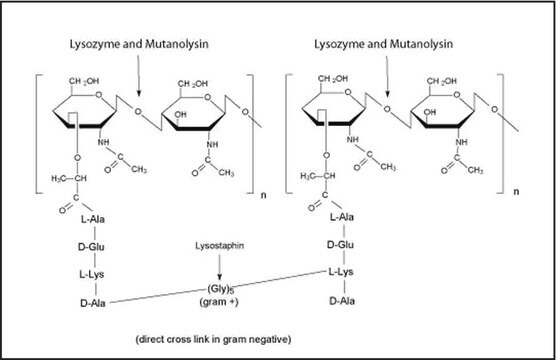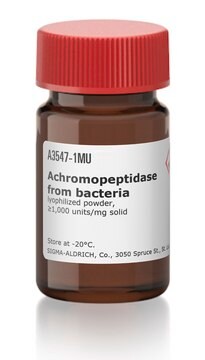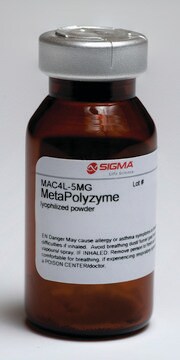SAE0092
Mutanolysin from Streptomyces globisporus ATCC 21553
free of DNA contaminants, suitable for Microbiome research, lyophilized powder, ≥4000 units/mg protein (biuret)
Synonym(s):
Mutanolysin
About This Item
Recommended Products
biological source
Streptomyces sp. (Streptomyces globisporus ATCC 21553)
form
lyophilized powder
specific activity
≥4000 units/mg protein (biuret)
mol wt
23 kDa
~18.5 kDa
feature
DNA free
concentration
≥40% protein
technique(s)
nucleic acid detection: suitable
suitability
suitable for cell lysis
application(s)
life science and biopharma
shipped in
wet ice
storage temp.
−20°C
Application
Mutanolysin is a muralytic enzyme, suitable for usage in isolation of nucleic acids, from Gram-positive bacteria (e.g. Listeria, Lactobacillus, Lactococcus),(8) and also from other bacteria that are difficult to lyse with lysozyme only.
Biochem/physiol Actions
Features and Benefits
Microbial DNA free, minimizing DNA contamination from reagents in workflow.
Suitable for the isolation of nucleic acids from Gram-positive bacteria, including Listeria, Lactobacillus, and Lactococcus.
Unit Definition
Physical form
Legal Information
signalword
Danger
hcodes
pcodes
Hazard Classifications
Resp. Sens. 1
Storage Class
11 - Combustible Solids
wgk_germany
WGK 2
flash_point_f
Not applicable
flash_point_c
Not applicable
Choose from one of the most recent versions:
Certificates of Analysis (COA)
Don't see the Right Version?
If you require a particular version, you can look up a specific certificate by the Lot or Batch number.
Already Own This Product?
Find documentation for the products that you have recently purchased in the Document Library.
Customers Also Viewed
Articles
Enzymes provide a non-mechanical method for cell lysis and protoplast preparation. It may seem like a simple process to throw in your enzyme, stick your tube in the water-bath and walk away, but what is actually going on in that process?
An overview of human microbiome research, workflow challenges, sequencing, library production, data analysis, and available microbiome reagents to support your research.
Our team of scientists has experience in all areas of research including Life Science, Material Science, Chemical Synthesis, Chromatography, Analytical and many others.
Contact Technical Service











